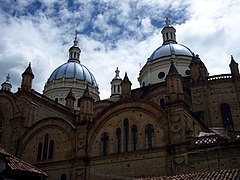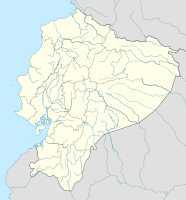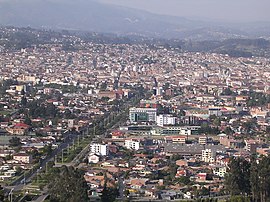Cuenca (Ecuador)
| Cuenca | ||
|---|---|---|
|
Coordinates: 2 ° 54 ′ S , 79 ° 0 ′ W Cuenca on the map of Ecuador
|
||
| Basic data | ||
| Country | Ecuador | |
| province | Azuay | |
| Canton | Cuenca | |
| City foundation | April 12, 1557 | |
| Residents | 329,928 (2010) | |
| - in the metropolitan area | 505,585 | |
| City insignia | ||
| Detailed data | ||
| surface | 70.6 km 2 | |
| Population density | 4,673 inhabitants / km 2 | |
| height | 2550 m | |
| City structure | 15 parroquias | |
| Waters | Río Tomebamba , Río Machángara , Río Yanuncay , Río Tarqui | |
| Post Code | 010150 | |
| prefix | (+593) 7 | |
| Time zone | UTC -5 | |
| City Presidency | Pedro Palacios Ullauri | |
| Website | ||
| View of the city from Turi | ||
| View across the Tomebamba River to Pumapunku | ||
Cuenca (from Spanish cuenca - " basin ") is with about 329,928 inhabitants the third largest city of Ecuador and capital of the province of Azuay . It is located south of Quito , according to its name in an Andean highland basin at an altitude of 2,450 to 2,600 m. The Río Tomebamba flows through the city, the smaller rivers Río Machángara , Río Yanuncay and Río Tarqui pass their northern and southern edges .
history
Cuenca was founded on April 12, 1557 by the governor and captain general of Quito Gil Ramírez Dávalos as Santa Ana de los Cuatro Ríos de Cuenca . He had received the order for this from the 3rd Viceroy of Peru , Andrés Hurtado de Mendoza , who had been governor of the Spanish Cuenca before taking office in 1555 .
Around 50 years earlier, the Inca Túpac Yupanqui had subdued the Kañari Indians in bloody battles here . On the site of the Kañari settlement Guapondelig, Tumipampa (Tomebamba) has now been built as a religious and cultural center on the main route from Cusco to Quito. When the first Spanish chroniclers reached Tumipampa in 1547 , the city was in ruins. This was probably due to the War of the Inca Succession between Huáscar and Atahualpa , in which the Kañari Indians had sided with the defeated Huáscar, followed by a punitive expedition by the victorious Atahualpa. The German archaeologist Max Uhle (1856–1944) "father of archeology in South America " and "founder of Andean archeology " discovered the foundations of the Inca palace Pumapunku (Pumapungo) and the Wiraqucha temple in 1925 . On the foundations of the palace there is now a museum of the Ecuadorian central bank.
The first Jesuit college was founded in 1638 by Francisco de Figueroa and Cristóbal de Acuña, the first rector. Monks were active until 1767 when the Jesuits had to leave Spanish territory. They returned in 1862, the college was briefly restored until 1876 when political problems again forced them to leave.
On November 3, 1820 , Cuenca was declared independent by Simón Bolívar . Forty years later, French Jesuits came to Cuenca and settled in a peaceful manner.
On July 11, 1983, a Boeing 737 passenger plane crashed near the city after an explosion . 119 inmates were killed.
Culture
| Old town of Cuenca | |
|---|---|
|
UNESCO world heritage |
|

|
|
| The new cathedral in the center of Cuenca |
|
| National territory: |
|
| Type: | Culture |
| Criteria : | II, IV, V |
| Reference No .: | 863 |
| UNESCO region : | Latin America and the Caribbean |
| History of enrollment | |
| Enrollment: | 1999 (session 23) |
In the most important square of the city, the Plaza Abdón Calderón , are the old cathedral (La Catedral Vieja), begun in 1557, with the oldest organ in Ecuador, and the new cathedral (La Nueva Catedral), begun in 1885 but not finally completed due to various earthquakes has space for up to 10,000 believers, as well as provincial and municipal authorities in representative buildings of the “republican style” of the 19th century . The old town was in 1999 on the list of World Heritage of UNESCO added. Cuenca is known as the " Athens of Ecuador". The Panama Hat Museum is located on Calle Larga , where old work processes in traditional straw hat making are demonstrated.
Azuay Province Government Palace
Economy and Infrastructure
Economically, Cuenca is an important national center of the ceramic industry, hat and basket weaving ( Panama hats ), leather processing and jewelry production in gold and silver. A disproportionately large number of Ecuadorian labor immigrants in the USA and Europe come from Cuenca and the surrounding area. But Cuenca also knows an influx of workers from Guayaquil and from abroad with its new Parque Industrial at the airport .
The city is home to Cuenca Airport , named after Mariscal Lamar , which connects Cuenca with Guayaquil and Quito. It is served by the four major airlines in the country.
The Cuenca bus system is efficient and fast with many bus routes and payment cards. City maps of the expanded center are available, but the public transport system is not mapped (2012). City buses also go directly to the thermal baths in Baños.
The city's public transport system was expanded on May 25, 2020 with the opening of the Tranvía Cuatro Ríos de Cuenca . The tram is expected to transport up to 106,000 passengers a day and up to 39 million passengers a year. The route network stretches from the southwest, sector Control Sur, over the center to the northeast, sector del Parque Industrial, of the city. The route includes 32 stops. The tram was christened "Tranvia Cuatro Ríos de Cuenca" because it runs close to the four rivers Tarqui, Yanuncay, Tomebamba and Machángara.
The solidarity of Father Crespi
One of the main representatives for solidarity work and activity in Cuenca was the Salesian Father Carlos Crespi Croci (also simply referred to as "Padre Crespi" by the population). He worked for about 50 years in the Salesian complex of Cuenca around the Mariahilf Church (iglesia María Auxiliadora) as a teacher, musician, conductor and cinema director and not only founded the orchestra of Cuenca, but was also the first in the region to run fundraising for the a very poor class back then. At communions and at Christmas he was regularly out with his little bell and distributed sweets to the children. All of this has a great role model function for the entire region, e.g. B. with the organization "Queens of Cuenca" ( Fundación Reinas de Cuenca ).
The collection of Father Crespi in Cuenca
Crespi also collected figures and relief metal plates from the past, from the Tayos Cave should (cueva de los Tayos) come and to him by the Ecuadorian Shuar - natives of the region were brought regularly, as much for its healing and for smaller amounts of money . Erich von Däniken made this Crespi fund known all over the world under the name Metal Library with his books. However, to this day, science does not take the authenticity of the collection seriously.
The alleged origin from the Tayos Cave has meanwhile been unmasked as a legend by several researchers. The actually existing but natural cave neither corresponds to the imaginative descriptions nor does it contain finds that can be linked to the Crespi Collection.
Town twinning
Cuenca has partnerships with Cusco , Peru (since 2000) and Xi'an , People's Republic of China (since 2010).
Sports
Cuenca hosted the 2007 three-cushion world championship .
The most famous sports club in the city is Deportivo Cuenca . 2004 the association of Ecuadorian champion who was Serie A .
sons and daughters of the town
- Abdón Calderón (1804–1822), hero in Ecuador's struggle for independence against Spain
- José Ignacio Ordóñez (1829-1893), Roman Catholic clergyman, Archbishop of Quito
- Daniel Hermida Ortega (1863–1956), Bishop of Cuenca
- Carlos Crespi Croci (Padre Crespi) (1891–30 April 1982), Salesian priest, teacher, musician, conductor, anthropologist, botanist, artist, cinema organizer and humanist
- Manuel de Jesús Serrano Abad (1898–1971), Archbishop of Cuenca
- José Gabriel Díaz Cueva (1925–2018), Roman Catholic clergyman, bishop of Azogues and auxiliary bishop in Guayaquil
- Guadalupe Larriva (1956–2007), politician
- Oswaldo Patricio Ventimilla Cabrera (* 1966), Catholic clergyman, Bishop of Azogues
- Jefferson Pérez (* 1974), track and field athlete and Olympic champion, the only Olympic champion in Ecuador
Web links
- Official website of the city administration (Spanish)
- Entry on the UNESCO World Heritage Center website ( English and French ).
- cuencanos.com - Site with information and forums from and for Cuencans around the world (Spanish)
- unofficial information site about Cuenca
Individual evidence
- ^ Jesuits in Ecuador. Retrieved April 14, 2020 .
- ↑ Really high: The new Tranvía Cuenca in Ecuador. In: Urban Transport Magazine. June 2, 2020, accessed on June 3, 2020 (German).
- ↑ Walter Hain: Errwege der Geschichte. Revision of the gods-astronauts and Atlantis . Hain, Vienna 1991.
- ↑ Asociation de Agencias de Turismo del Cusco: Ciudades hermanas
- ↑ Website of Xi'an Municipal People's Government: Sister Cities ( Memento of October 24, 2016 in the Internet Archive ) (English)
- ^ Father Crespi http://www.goldlibrary.com/father_crespi.html









